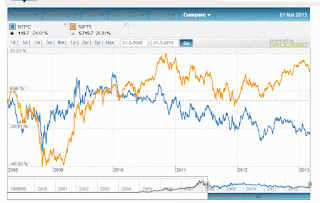This company was incorporated in 1994 and came out with an IPO in May 1997. As per the company itself it serves consumers, sellers, enterprises and content creators. The business is seasonal with the largest contribution (take a third) to revenue taking place during the last quarter ending December each year.
But the interesting part is the journey which has been amazing. To see why, just have a look at this:
In the 13 years which ended on 31 Dec 2011 the revenues increased at an annual rate of 40%. Operating losses were turned into profits of $862 million pretax. Even with very low margins the return on capital is mind-boggling. Return on equity is pretty decent considering the current times.
Virtually entire capital funded by debt and equity is sitting in cash. It seems like this business is actually funded by suppliers (trade payables) and customers (advances). Isn't this amazing? If you are a business owner and are able to squeeze both customers (less or no credit) and suppliers (more credit) on a long term basis, you probably have immense competitive advantages and entry barriers. In 2011 the company had about $788 million of unredeemed gift certificates (advances) which if not redeemed will go to revenue.
It operates in a highly competitive environment but has done well. Just in case you are wondering which company could this be, here it is. And the reward to the shareholders:
Not bad for (an online) retailer business.
As Jeff Bezos said in his 1997 letter to shareholders, it's all about the long term. The business was first started to take advantage of the then ruling that online retailers did not have to collect sales taxes in states where they lacked a physical presence.
The question is: Could anyone have thought in 1998 that this loss-making business would one day sell at about $120 billion? Well, not many.







